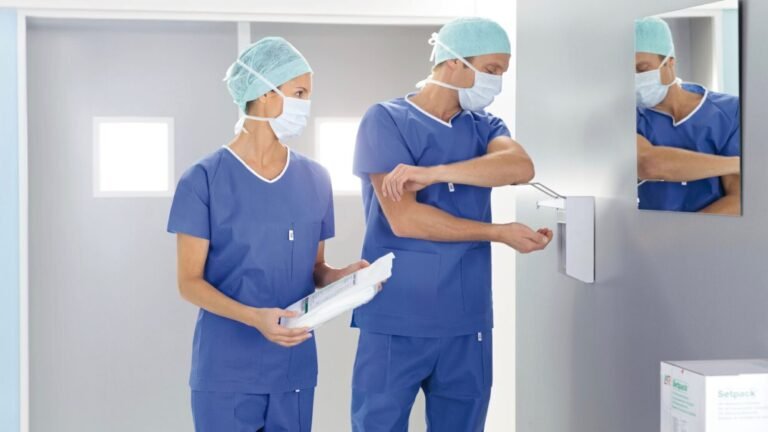In the healthcare industry, maintaining Surgical Scrubs a sterile environment is crucial, especially in surgical settings where the risk of infection is high. Surgical scrubs play a vital role in this context, serving as the first line of defense against contamination. This article explores the importance of surgical scrubs, the standards and features they must meet, the benefits they offer, and best practices for their use and maintenance.
Importance of Scrubs
Surgical are specialized clothing worn by medical professionals, including surgeons, nurses, and technicians, during surgical procedures. Their primary purpose is to maintain a sterile environment in the operating room (OR) by minimizing the presence of contaminants that could lead to infections. The importance of surgical scrubs extends beyond just the operating room; they symbolize cleanliness, professionalism, and a commitment to patient safety.
Standards and Features of Surgical Scrubs
To ensure maximum protection and functionality, surgery scrubs must adhere to specific standards and possess certain features:
- Material: High-quality surgical scrubs are typically made from a blend of polyester and cotton. This combination provides durability, comfort, and the ability to withstand frequent washing at high temperatures necessary for sterilization.
- Antimicrobial Properties: Modern scrubs often incorporate antimicrobial treatments to inhibit the growth of bacteria and fungi. This added layer of protection is critical in reducing the risk of cross-contamination.
- Fluid Resistance: Surgical scrubs should be designed to resist fluids to protect healthcare workers from exposure to blood and bodily fluids, which is particularly important during invasive procedures.
- Comfort and Fit: Scrubs should be comfortable and allow for ease of movement, as medical professionals often wear them for extended periods. Proper fit is essential to avoid any distractions or discomfort during critical tasks.
- Color and Design: While the classic colors for scrubs are green or blue, used to reduce glare from surgical lights and contrast with blood and body tissues, scrubs are available in various colors and designs to denote different roles and departments within the hospital.
Benefits of Surgical Scrubs
- Infection Control: The primary benefit of surgical scrubs is their role in infection control. By wearing clean, sterilized scrubs, healthcare professionals reduce the risk of introducing harmful pathogens into the surgical environment.
- Professionalism: Uniform scrubs contribute to a professional appearance, which can instill confidence in patients. They also help in easily identifying medical personnel, enhancing communication and coordination within the healthcare setting.
- Convenience: Scrubs are designed for practicality. They have pockets for carrying essential tools and supplies, which is crucial for efficiency in a fast-paced medical environment.
- Cost-Effective: Surgical scrubs are durable and designed to withstand frequent laundering, making them a cost-effective option for hospitals and clinics. Their longevity ensures that they can be used over extended periods without significant wear and tear.
Best Practices for Use and Maintenance of Surgical Scrubs
To maximize the effectiveness and lifespan of surgical scrubs, it is important to follow best practices for their use and maintenance:
- Proper Donning and Doffing: Healthcare workers should follow proper procedures for putting on and taking off scrubs to minimize the risk of contamination. This includes thorough hand hygiene before donning scrubs and careful removal to avoid contact with potentially contaminated areas.
- Laundering: Scrubs should be washed in hot water with hospital-grade detergents and disinfectants. Regular laundering at high temperatures helps eliminate bacteria and other pathogens, ensuring that scrubs remain sterile.
- Storage: Clean scrubs should be stored in a dry, sterile environment to prevent contamination before use. They should be kept separate from street clothes and other non-sterile items.
- Regular Inspection: Scrubs should be regularly inspected for signs of wear and tear, such as thinning fabric or damaged seams. Any scrubs that are compromised should be replaced immediately to maintain the highest standards of protection.
- Personalization and Fit: While personalization can help in quick identification, it is important to ensure that any customizations do not compromise the sterility and integrity of the scrubs. Proper fit is essential for comfort and functionality.
- Avoiding Home Laundering: Surgical scrubs should ideally be laundered by professional services provided by the healthcare facility to ensure that proper sterilization protocols are followed. Home laundering can introduce contaminants and is generally not recommended.
Read more information: https://bmseoblogs.com/
Conclusion
Surgical scrubs are a fundamental component of the healthcare industry, particularly in surgical settings where maintaining a sterile environment is paramount. Adhering to standards and best practices in their use and maintenance ensures that they provide the necessary protection against infections while also contributing to a professional and efficient healthcare environment. By investing in high-quality surgical scrubs and following stringent care protocols, healthcare facilities can enhance patient safety, support their medical staff, and uphold the highest standards of clinical hygiene
